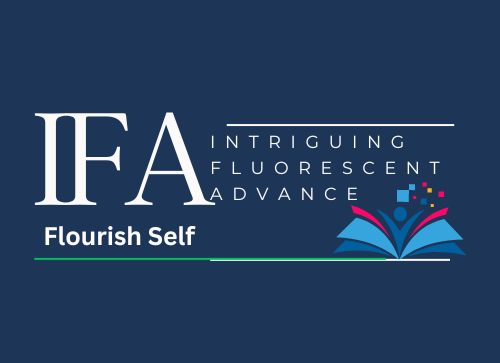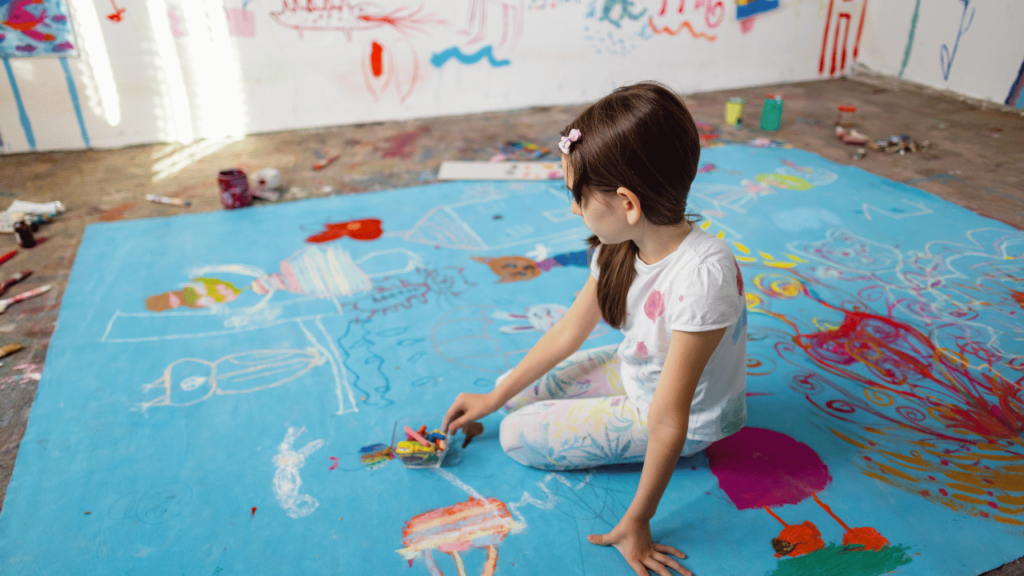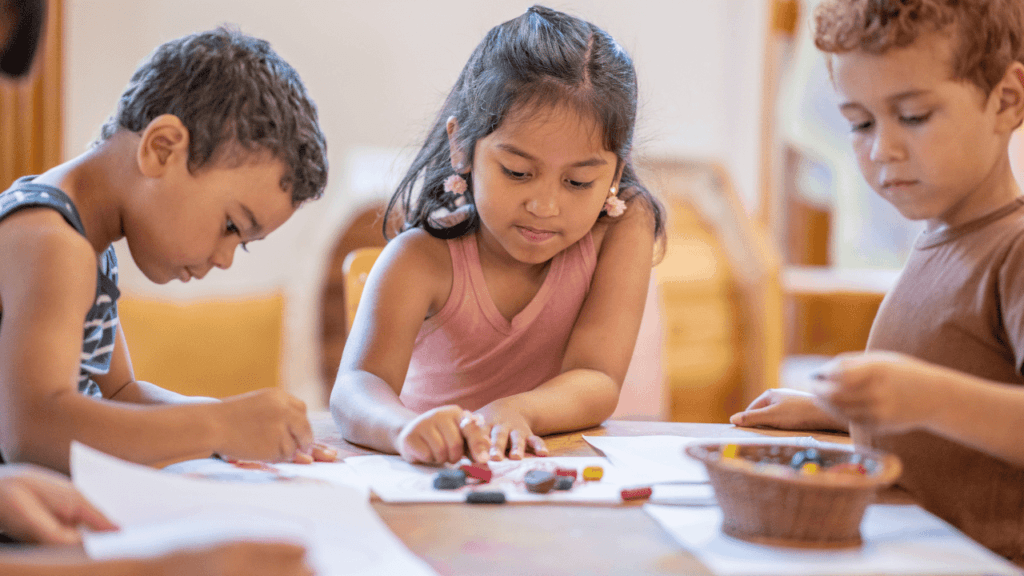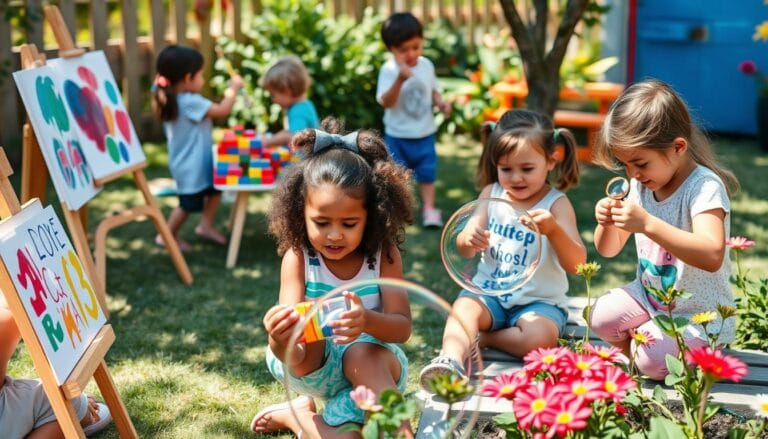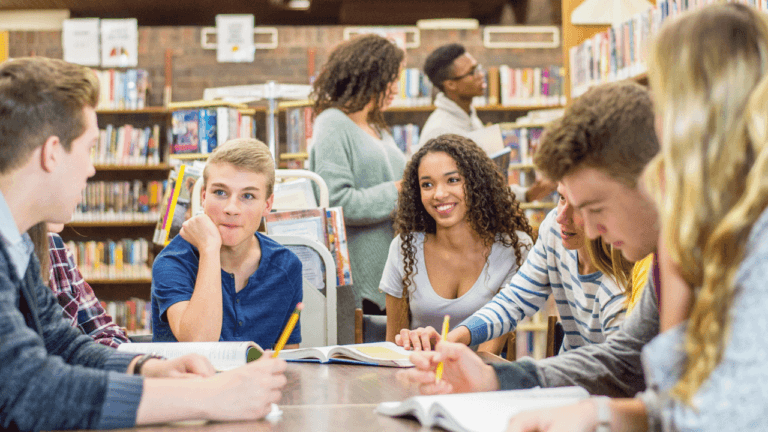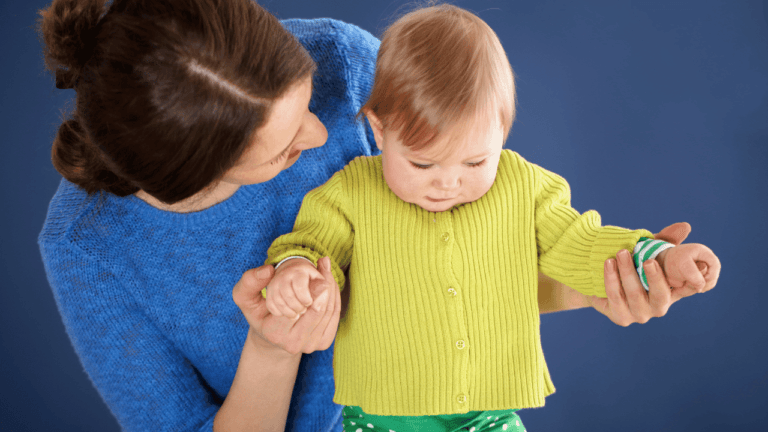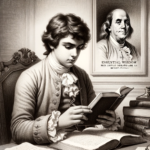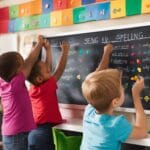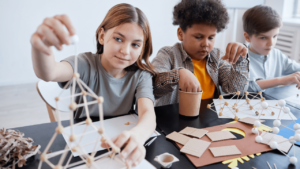
Fostering Art and Creativity Development in Education
The role of education in enhancing art and creativity development is crucial for nurturing innovative and expressive minds. Providing ample opportunities for students to experiment, explore their artistic abilities, and think creatively is essential. Art education goes beyond teaching technical skills, as it also promotes the appreciation of art’s value in society and fosters empathy and understanding towards others.
Visual arts education plays a significant role in the artistic growth and imagination development of students. It enables them to explore innovative artistic techniques and express their unique perspectives through various mediums.
Key Takeaways:
- Art and creativity development plays a crucial role in nurturing innovative and expressive minds.
- Visual arts education enhances artistic growth and imagination development.
- Art education fosters empathy and understanding towards others.
- Providing opportunities for students to experiment and think creatively is essential.
- Art education promotes the appreciation of art’s value in society.
The Importance of Art in Education
Art plays a crucial role in education, offering numerous benefits that go beyond the development of technical skills. It serves as a powerful tool for self-expression and exploration, allowing students to communicate thoughts and emotions that may be challenging to express verbally. Through creative expression, students can convey their ideas and experiences in a unique and personal way.
Art also fosters the development of creative thinking skills. By engaging in artistic activities, students are encouraged to think outside the box, envision new solutions, and approach challenges from different perspectives. This cultivates their ability to think innovatively and enhances their problem-solving skills.
Furthermore, art enhances critical observation skills as it requires careful analysis and attention to detail. When creating art, students learn to observe the world around them with a discerning eye, noticing intricate details and interpreting them in their work. This cultivates a sense of careful observation and encourages students to think critically.
The Therapeutic Power of Art
Art also has therapeutic benefits, providing individuals with a creative outlet for emotional expression and exploration. Through art therapy, individuals can tap into their inner thoughts and feelings, gaining a deeper understanding of themselves and their experiences. It allows for the processing of emotions, alleviation of stress, and exploration of personal growth.
By incorporating art into education, students are not only exposed to various artistic techniques but also gain valuable skills in creative expression, critical thinking, and observation. The integration of art in education fosters a holistic approach to learning, enabling students to develop their artistic abilities alongside other academic disciplines.
Integrating Art in Education
Integrating art in education can greatly enhance the learning experience for students. By incorporating visual arts education, innovative artistic techniques, and fostering imagination development, educators can create a dynamic and engaging environment that supports students’ holistic growth.
STEAM Education: Nurturing Analytical Thinking and Creativity
One approach to integrating art in education is through the implementation of STEAM (Science, Technology, Engineering, Arts, and Mathematics) programs. STEAM education combines art with other disciplines, promoting analytical thinking alongside creativity. By incorporating the visual arts into STEM subjects, students develop a well-rounded skill set that encompasses both scientific inquiry and artistic expression.
STEAM education encourages students to think critically, synthesize information, and approach problems from multiple perspectives. This interdisciplinary approach cultivates innovative artistic techniques and supports the development of creative problem-solving skills.
The Value of Art Projects: Cultivating Perseverance and Empathy
Art projects offer valuable opportunities for students to explore their creativity, learn from mistakes, and develop resilience. Engaging in art activities teaches students the value of persistence and adaptability, as they navigate the various stages of the artistic process.
In addition to fostering perseverance, art projects also promote empathy and cultural understanding. By introducing students to diverse art forms from different cultures, art education encourages empathy and appreciation for the perspectives and experiences of others. This exposure to different artistic traditions fosters a sense of global citizenship and promotes cultural inclusivity.
Imagination Development: Unleashing Creative Potential
Integrating art in education significantly contributes to the development of students’ imagination. Art provides a platform for self-expression, allowing students to unleash their creative potential and express their thoughts and emotions. Through various visual arts mediums, such as drawing, painting, and sculpting, students engage in open-ended exploration, expanding their imaginative thinking and problem-solving abilities.
By encouraging imagination development, educators empower students to think outside the box, explore innovative artistic techniques, and approach challenges with a fresh perspective. This creative mindset fosters a lifelong love for learning and encourages students to seek innovative solutions in all areas of their lives.
Incorporating art in education not only enriches the learning experience but also nurtures students’ artistic growth, cultivates creative thinking skills, and promotes cultural understanding. By integrating visual arts education, innovative artistic techniques, and fostering imagination development, educators can create a vibrant and inclusive learning environment that empowers students to thrive both academically and creatively.
Art as a Tool for Expression and Exploration
Art provides a powerful medium for students to express their innermost thoughts and emotions, allowing them to communicate in ways that may be challenging to convey verbally. Through creative expression, students can explore and unleash their individuality, establishing a deeper connection with themselves and the world around them.
One form of artistic expression that holds immense therapeutic value is art therapy. Art therapy combines traditional counseling techniques with creative processes to promote healing and self-discovery. It offers individuals a safe space to explore their emotions, enhance self-awareness, and develop healthier coping mechanisms.
Benefits of Art Therapy
Art therapy provides a range of benefits for individuals of all ages and backgrounds:
- Emotional Release: Art offers a cathartic outlet for expressing difficult emotions, such as sadness, anger, or anxiety. It allows individuals to externalize their feelings and gain a sense of relief and release.
- Self-Exploration: Through art, individuals can delve into their subconscious mind and explore complex thoughts and memories. It provides a platform for self-reflection and deeper understanding.
- Stress Reduction: Engaging in creative activities can significantly reduce stress levels by diverting attention away from daily worries and promoting a state of relaxation and flow.
- Self-Confidence: Artistic expression fosters self-confidence as individuals witness the unique creations they bring into existence. It encourages originality and self-validation.
- Communication Enhancement: Art transcends language barriers and enables individuals to communicate and connect with others on a deeper emotional level. It can be particularly beneficial for those who struggle with verbal expression.
Art therapy techniques can encompass a wide range of mediums, including painting, drawing, sculpture, collage, and even digital art. The choice of medium is based on individual preferences and goals, as different art forms can evoke distinct emotions and experiences.
| Art Therapy Techniques | Description |
|---|---|
| Collage | The art of combining various materials like paper, fabric, and photographs to create a cohesive composition that represents one’s self. |
| Sculpture | Working with clay or other sculpting materials to express internal emotions or create tangible representations of abstract concepts. |
| Painting | Using brushes, acrylics, watercolors, or other paint mediums to convey a wide range of emotions, thoughts, and experiences on canvas or paper. |
Art therapy not only helps individuals connect with their inner selves but also provides an avenue for self-expression in a non-judgmental and supportive environment. By utilizing the power of creative expression, art therapy facilitates personal growth, emotional healing, and self-discovery.
The Impact of Art in the Classroom
Incorporating art into the classroom environment has a profound impact on students’ artistic growth and their development of creative thinking skills. By providing dedicated furniture and designated areas for art activities, educators create an atmosphere that fosters imagination and allows students to showcase their creations.
Art activities stimulate students to think innovatively, encouraging them to explore different perspectives and develop problem-solving and critical thinking skills. Through hands-on artistic experiences, students learn to approach challenges creatively, discovering unique solutions that they might not have otherwise considered.
Having art as an integral part of the classroom also cultivates collaboration and self-expression. It provides a platform for students to communicate their thoughts and emotions in ways that may be challenging to express verbally. By encouraging students to experiment, take risks, and push their creative boundaries, educators nurture artistic growth and empower students to develop their unique artistic voices.
Art education in the classroom also enhances students’ overall academic performance and engagement. It creates a well-rounded learning experience that integrates different disciplines, fostering interdisciplinary connections and reinforcing the understanding of core concepts. By connecting art to other subjects, such as science, history, or literature, educators create opportunities for students to develop a deeper understanding and appreciation of these subjects.
The impact of art in the classroom goes beyond just artistic skills. It promotes a culture of creativity, open-mindedness, and innovation, which are essential qualities in the rapidly changing world we live in. By providing students with the tools and opportunities to engage in artistic expression, educators lay the foundation for their lifelong creative journey and equip them with the skills they need to thrive in any field.
Art as a Catalyst for Innovation
The field of art is not only about creativity and self-expression but also serves as a powerful catalyst for innovation. Through the exploration of innovative artistic techniques, students can develop their creative thinking skills and uncover unique solutions.
Artistic processes often require innovative approaches, pushing students to think beyond conventional boundaries. By experimenting with different materials, techniques, and concepts, students learn how to approach challenges from multiple perspectives, fostering their ability to think creatively and envision new possibilities.
One example of innovative artistic techniques is collage, where students combine various materials and objects to create new visual narratives. This artistic practice encourages divergent thinking, as students experiment with different combinations and juxtapositions. Through collage, students not only hone their creative thinking skills but also develop their ability to find connections between seemingly disparate elements.
The image above captures the essence of innovative artistic techniques, showcasing how artists merge different materials to create unique and thought-provoking artworks.
The Role of Creative Thinking Skills
Creative thinking skills are essential for innovation and problem-solving across various disciplines. Art education provides an ideal platform for cultivating these skills by encouraging students to think critically and approach artistic projects through imaginative lenses.
By integrating creative thinking skills, students can draw connections between art and other subjects, creating interdisciplinary learning opportunities. For example, incorporating science and engineering principles into art projects allows students to explore the intersection of creativity and technicality, fostering a unique blend of innovation.
Real-World Applications
The development of innovative artistic techniques and creative thinking skills extends beyond the art classroom. These skills have real-world applications in fields such as design, architecture, technology, and entrepreneurship.
Designers, for instance, rely heavily on creative thinking to develop innovative solutions that address user needs and enhance usability. Architects explore new materials and design concepts to revolutionize the way we interact with our built environment. Entrepreneurs utilize creative thinking to identify market gaps and develop groundbreaking products and services.
| Artistic Technique | Application |
|---|---|
| Photography | Documentary photography can be used to raise awareness about social issues or showcase innovative products. |
| Sculpture | Architects often incorporate sculptural elements into building designs to add aesthetic appeal and create unique spatial experiences. |
| Graphic Design | Graphic designers utilize innovative techniques to create visually striking branding materials and advertising campaigns. |
The table above demonstrates some real-world applications of different artistic techniques. Each technique has the potential to inspire innovation and creative problem-solving in various fields.
Conclusion
Art and creativity development are integral components of a well-rounded education. By nurturing imagination, fostering innovation, and promoting empathy, art education unlocks students’ artistic potential and equips them to make a positive impact in the world.
Integrating art across subjects creates a holistic learning experience, combining artistic techniques with academic concepts to enhance understanding and engagement. By providing a safe and inclusive environment, students are encouraged to think creatively, problem-solve, and express themselves authentically through artistic means.
Through art, students develop critical skills such as observation, analysis, and creative thinking. Innovative artistic techniques challenge them to approach challenges from unique angles, fostering resilience and adaptability. Imagination is nurtured, allowing students to envision new possibilities and explore diverse perspectives.
Art and creativity development in education not only cultivate artistic talent but also instill lifelong skills essential for success in an ever-changing world. By investing in art education, we empower students to embrace their creativity, think innovatively, and contribute meaningfully to society.
FAQ
How does art education enhance art and creativity development?
Art and creativity development provide students with ample opportunities to experiment, explore their artistic abilities, and think creatively. It goes beyond teaching technical skills and promotes the appreciation of art’s value in society, nurturing innovative and expressive minds.
What role does art play in self-expression and exploration?
Art serves as a pathway for individuals to communicate thoughts and emotions that may be challenging to express verbally. It allows for creative expression and fosters imagination, encouraging students to think outside the box and envision new solutions.
How does integrating art in education enrich the learning experience?
Integrating art in education, such as in STEAM (science, technology, engineering, arts, and mathematics) programs, promotes analytical thinking alongside creativity. Art projects also cultivate perseverance and resilience, while introducing students to diverse art forms promotes cultural understanding and empathy.
What is the role of art therapy in personal growth and emotional intelligence?
Art therapy provides individuals with a creative means to explore and express their inner thoughts and feelings. It serves as an outlet for personal growth, enhances emotional intelligence, and promotes self-awareness and healing.
How does art impact the classroom environment?
Art activities in the classroom foster artistic growth and allow students to showcase their creations. By encouraging creative thinking and problem-solving skills, art education empowers students to develop their critical observation skills and attention to detail.
How does art foster innovation in students?
Artistic techniques and processes often require innovative approaches, encouraging students to think creatively and develop unique solutions. By fostering creative thinking skills through art education, students develop the ability to approach challenges from different perspectives and envision new possibilities.
What is the overall impact of art and creativity development in education?
Art and creativity development in education foster imagination, innovation, and empathy. By integrating art across subjects, providing a safe and inclusive learning environment, and encouraging students to think creatively, education can unlock students’ artistic potential and empower them to make a positive difference in the world.
